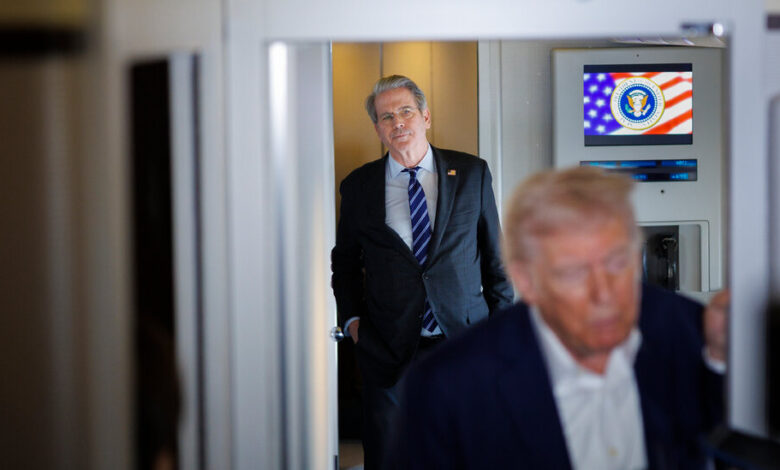Trump’s Give-and-Take Tariff Strategy – The New York Times

The Trump administration’s latest response: refocus the message.
Where things stand: Trump’s give-and-take tariffs strategy was on full display on Monday with the president signaling he would consider an exemption for auto parts — “they need a little bit of time” to bring back manufacturing to the United States — but reiterating that levies on chips and pharmaceuticals were coming.
Auto stocks rallied on the news. But Nvidia, the chips giant that became the latest tech giant to promise a major domestic spending initiative, was down in premarket trading on Tuesday.
Trump’s on-again-off-again policy has pushed some traders to the brink. Global investors have dumped their U.S. stocks at a record clip during the past two months, a Bank of America investor survey released this morning shows. They also fear tariffs sinking the global economy.
Fed officials and C.E.O.s increasingly share those downturn concerns:
-
David Solomon of Goldman Sachs never mentioned “tariffs” on his bank’s earnings call on Monday, but he did warn that recession odds have increased. On the bright side: Market volatility fueled huge gains on Wall Street trading desks, including Goldman’s.
-
LVMH warned that even its well-heeled customers were pulling back on purchases. Its shares fell sharply on Tuesday — along with much of the sector — as the luxury goods giant warned that trade war uncertainty may force it to raise prices.
-
Raphael Bostic, the president of the Atlanta Fed, said that companies faced a “fog” of uncertainty over shifting tariffs policy, putting the economy “in a big pause position.” His take: The Fed will have to go slow on cutting interest rates.
What Trump officials are saying: Kevin Hassett, the director of the National Economic Council, played down recession fears. And Treasury Secretary Scott Bessent said there was “no evidence” that foreign countries were dumping Treasury notes and bonds.
The White House, Bessent added, has a “strong dollar” policy, despite Trump’s longstanding grumbles about its effect on exports. (More on the dollar below.)
Of note, Bessent threw his support behind the Fed. The Treasury secretary said he meets weekly with the Fed chair, Jay Powell, signaling that relations between the administration and central bank are solid. “I believe that monetary policy is a jewel box that’s got to be preserved,” he told Bloomberg Television, playing down concerns that the White House might seek to pressure it to lower rates.
Bessent added that the administration would begin interviewing candidates in the fall who could replace Powell, whose term ends next year.
DEALBOOK WANTS TO HEAR FROM YOU
We’d like to know how the tariffs are affecting your business. Have you changed suppliers? Negotiated lower prices? Paused investments or hiring? Made plans to move manufacturing to the U. S.? Or has it helped your business? Please let us know what you’re doing.
HERE’S WHAT’S HAPPENING
Representative Marjorie Taylor Greene discloses she traded stocks and bonds ahead of the tariffs rally. The Georgia Republican bought between $21,000 and $315,000 of equities and sold off Treasury bonds the day before President Trump ordered a 90-day delay on tariffs, which prompted a market surge. That comes as Democrats like Senator Elizabeth Warren of Massachusetts call for an investigation into people in Trump’s orbit. (The Trump administration has denied there was any illegal trading.)
The Trump administration defies the Supreme Court twice in one day. The White House refused an order to bring back Kilmar Armando Abrego García, a Salvadoran immigrant who was mistakenly deported. In an Oval Office meeting with the president of El Salvador on Monday, Secretary of State Marco Rubio said, “No court in the United States has a right to conduct the foreign policy of the United States.” The White House also refused to admit journalists from The Associated Press to the Oval Office event, defying another Supreme Court order.
Netflix reportedly pursues a $1 trillion valuation. The streaming giant has shared internally an ambitious five-year plan to double revenue — with a big chunk coming from ad sales — and boost its share price, The Wall Street Journal reports. But to achieve that, the company would need to drastically increase its global subscriber numbers amid the uncertainty of a trade war.
A playbook against Trump emerges
In the first major challenge to President Trump’s pressure campaign on higher education, Harvard rejected the administration’s latest demands, calling them a violation of the institution’s First Amendment rights.
“No government — regardless of which party is in power — should dictate what private universities can teach, whom they can admit and hire, and which areas of study and inquiry they can pursue,” Alan Garber, the president of Harvard, said in a statement.
It’s another significant rebuke of Trump after law firms like Perkins Coie sued the administration over executive orders that would cripple their ability to represent clients. What’s emerging is a playbook for how to stand up to the Trump White House.
Catch up: The president has targeted major universities for what he says is insufficiently combating discrimination like antisemitism. In the case of Harvard, the administration has issued demands including that it share all hiring data and that it overhaul academic departments and schools like the Medical School.
After Harvard rejected those demands, White House officials said on Monday that the government would freeze $2.2 billion in grants to Harvard, along with a $60 million contract. Last month, the administration said that it was examining about $9 billion in federal grants and contracts for the university.
Some in the legal world have already taken on Trump. When Perkins Coie sued the Trump administration, the nation’s 10 largest firms by revenue did not back the fight, though more than 500 others signed a friend of the court brief in support of its lawsuit.
That underscores an emerging divide among law firms. Paul Weiss created a template for settling with Trump by agreeing to provide pro bono services to causes he supports, which other major corporate firms have followed.
A similar divide is emerging among universities. Last month, Columbia agreed to major concessions after the Trump administration stripped it of $400 million in federal funds. But the president of Princeton recently spoke out against the administration’s threats to withhold federal money.
Some of the key players in the Harvard fight have ties to Trump. The lawyers behind the school’s response are William Burck of Quinn Emanuel and Robert Hur of King & Spalding. Hur worked in the Justice Department under the first Trump administration who as special counsel investigated President Joe Biden’s handling of classified materials.
Burck has represented Trump’s business organization and also advised Paul Weiss as it negotiated with the White House.
Zuckerberg on the stand
Mark Zuckerberg used his first day of testimony at the F.T.C.’s antitrust trial against Meta to try to undercut the government’s efforts to dismantle his tech giant.
The basic thrust: Meta’s competition is a lot bigger than what the F.T.C. says it is.
Meta does more than connect friends and family, Zuckerberg testified. While that’s core to the company — and the focus of the F.T.C.’s case that Meta illegally deprived consumers of other social networking options — he said that the company ultimately is in the business of “entertainment and learning about the world and discovering what’s going on.”
Meta’s lead lawyer, Mark Hansen, added that the company faced strong competition, especially from TikTok. (One proof point: When TikTok was briefly banned in the U.S. in January, Facebook and Instagram saw a surge in use, he said.)
“This case is a grab bag of F.T.C. theories at war with fact and at war with the law,” Hansen said. He also called the agency’s definition of the social media market “gerrymandering.”
Zuckerberg also sought to play down old emails between him and lieutenants. When asked about a 2012 email in which he discussed buying Instagram but then not adding new features, Zuckerberg said that represented “relatively early thinking.” He noted that his team ultimately invested a lot into the photo and video app. (The marketing company Emarketer estimated in December that Instagram represented a little more than half of Meta’s U.S. ad sales.)
What commentators are saying:
-
“The government’s case is carefully designed to skirt the issue of TikTok’s impact on the market,” writes The Information’s Martin Peers.
-
“The idea that Meta’s feeds have expanded beyond their historic friends-and-family origins should be settled fact,” writes Platformer’s Casey Newton.
The dollar keeps dropping. It’s complicated.
The U.S. dollar is usually considered a haven during tumultuous times. But since January, it has fallen about 8 percent against other major currencies. And the yields on the benchmark 10-year U.S. Treasury bond rose last week to about 4.5 percent, from less than 4 percent the week before.
The dollar and Treasuries usually thrive when stocks stutter. It has led to a lot of chatter about whether global investors are pulling back from the U.S. or if it’s something more technical, like the basis trade, or a sell-off by foreign governments. Sarah Kessler spoke with John Canavan, the lead analyst at the advisory firm Oxford Economics, about how to understand the debate.
The interview has been edited and condensed.
How do you think about what is happening right now? Is the U.S. losing its brand as a haven?
It’s a concern, but it’s not an emergency. We have already seen President Trump begin to acknowledge some of these risks and concerns, and that has relieved some of the pressure.
The U.S.’s economic strength, the size and liquidity of the U.S. asset markets and the U.S. Treasury market: These are all things that are going to allow the U.S. to remain a key source of safe-haven supply for the rest of the world, even if not the only source as it has been in the past.
What would need to change for you to think it’s an emergency?
Global markets are interconnected; there’s no way to fully avoid that. If we’re to shut ourselves off from the world more significantly, I think that’s when it would start to become a little bit more of an emergency situation for the dollar and for Treasuries.
Treasury Secretary Scott Bessent has said the bond sell-off could be attributed to large investors trying to cover losses. How plausible is this?
There has been a lot of talk and speculation about an unwinding of basis trades being partly responsible for what we’ve been seeing, but data released by the C.F.T.C. on Friday strongly suggested that this was not an unwinding of basis trades.
Evidence of basis trades, as seen in the data, has been a very large and growing short base in Treasury futures among leveraged investors, and a large and growing long position in Treasury futures by asset managers. And in fact, those positions grew last week, through last Tuesday, rather than shrinking, as you would expect if that trade was unwinding.
The new data really helped to strengthen the point that you can’t be sure who is selling — and why. You can’t be sure that it wasn’t foreign investors. We don’t have the evidence to know for sure one way or the other.
THE SPEED READ
Deals
Politics, policy and regulation
Best of the rest
We’d like your feedback! Please email thoughts and suggestions to [email protected].




